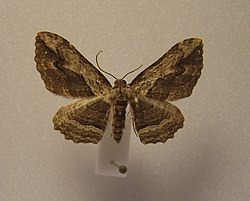| Austrocidaria bipartita | |
|---|---|
 | |
| Scientific classification | |
| Kingdom: | Animalia |
| Phylum: | Arthropoda |
| Class: | Insecta |
| Order: | Lepidoptera |
| Family: | Geometridae |
| Genus: | Austrocidaria |
| Species: | A. bipartita |
| Binomial name | |
| Austrocidaria bipartita (Prout, 1958) | |
| Synonyms [1] | |
| |
Austrocidaria bipartita is a species of moth of the family Geometridae. [1] It endemic to New Zealand. It was first described by Louis Beethoven Prout in 1958. This species is found throughout New Zealand and adults are on the wing all year round. Adults are nocturnal and are attracted to light. The larval host plants of this moth are species in the genus Coprosma .

